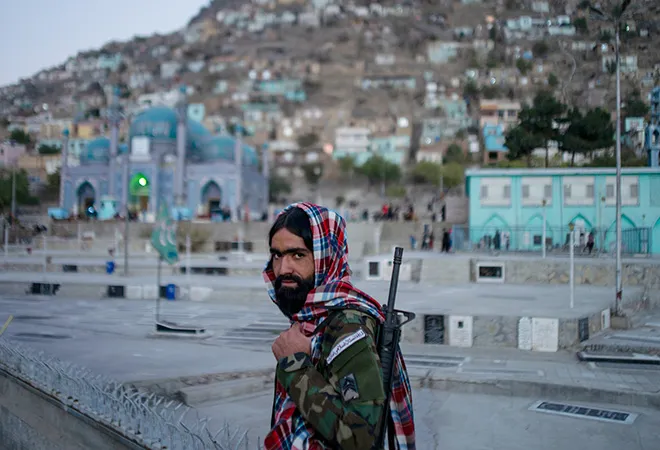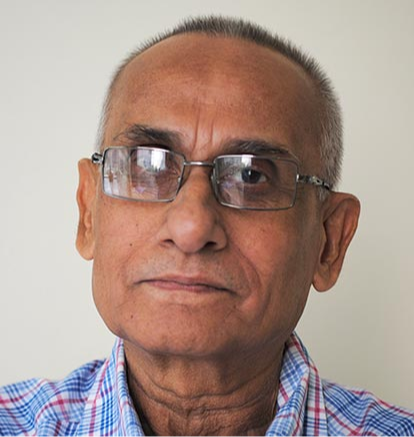-
CENTRES
Progammes & Centres
Location
With the reinstallation of the Taliban’s power in 2021, a humanitarian nightmare still persists

This piece is part of the essay series, Instability in India’s neighbourhood: A multi-perspective analysis
Nearly a year before on 15 August 2021, America’s longest war in history against the Taliban in Afghanistan came to an end. During the last 20 years, the United States (US) tried to establish a democratic regime with a strong civil society, marked by respect for human rights and fundamental freedoms, especially for women and girls. The comeback of the Taliban, without much change from its earlier incarnation, proved again that regime change from outside is nearly an impossible task.
The Taliban could humble a great power like the US, not because it could gather superior military power, but because of the fragility of the Afghan government as well as of the Afghan National Army that the US tried so hard to build.
The Taliban’s religious ideology was a combination of ‘Deobandi traditionalism and Wahhabi puritanism’, on the one hand, and conservative Pashtun social code on the other.
The origins of the Taliban could be traced back to the early 1990s when after the end of Soviet–Afghan War, the new Afghan government failed to create civil order and to subdue warlordism. Under the circumstance of lawlessness, ordinary Afghans began liking the religious rhetoric of the ‘mujahideen’. By 1994, the ‘mujahideen’ fighters, associated with a madrasah in a village in Kandahar, started gathering popular support and were able to defeat warlordism to establish peace and order in the region They came to be known as the Taliban, and within two years they captured Kabul and established control over a large part of the Afghan territory.
The Taliban’s religious ideology was a combination of ‘Deobandi traditionalism and Wahhabi puritanism’, on the one hand, and conservative Pashtun social code on the other. The product was a brutally repressive regime with the total exclusion of women from public life, unhesitating destruction of non-Islamic historic relics, and a medieval system of criminal punishment resulting in a humanitarian crisis within Afghanistan. The Pashtun hegemony it established was unsuccessfully resisted by non-Pashtuns. The regime, however, went ahead collaborating with Islamic militancy, hosting the al-Qaeda, hijacking aeroplanes for demanding the release of well-known terrorists and committing other acts. The US attacked (2001) the regime when it refused to hand over al-Qaeda chief Osama bin Laden, despite his role in the 9/11 attacks. That is how the war against the Taliban started.
Even though the US and NATO had driven the Taliban out and installed a new government, the Taliban continued to survive, regroup, and increase its popular support, especially in the south and east of Afghanistan. The death of its founding leader, Mullah Mohammad Omar in 2013, did not stop it from expanding, recruiting new leaders, and having huge followership despite the NATO military operations inflicting a lot of death and destruction. By the middle of the second decade of 2021, the US realised it was an unwinnable war.
According to it “Taliban wants a peaceful transfer of power” and supports an “Afghan Islamic-inclusive government”, where “women can have access to education and to work.
In 2018, the US started negotiating with the Taliban with the help of Saudi Arabia, Pakistan, and the United Arab Emirates. Its efforts to bring the Central Afghan government and the Taliban together did not work. In February 2020, they reached a deal under which the US would withdraw fully in exchange for the Taliban’s commitment not to allow Islamic militant groups to operate from Afghanistan. As the US declared withdrawal by August 2021, the resurgent Taliban quickly extended its control over numerous provinces, finally capturing Kabul.
When the Taliban came back to power in 2021, many hoped that it would change in its second incarnation it would try to accommodate itself by acquiring a humane face to win friends and international acceptability. Also, many hoped that it would try to understand and accept the changes that had already occurred in the Afghan society. This was noted in the tenets of a script authored in Doha, that the Taliban were keen to promote peace after their takeover of Kabul in August 2021. According to it “Taliban wants a peaceful transfer of power” and supports an “Afghan Islamic-inclusive government”, where “women can have access to education and to work. They just need to “observe the hijab”.
Indeed, the Taliban’s takeover was not as brutal as it was in 1996. Yet, gradually it reverted to its previous form, where women were stopped from working in public offices and were being forced to withdraw from public life, higher education for girls was denied, and the brutal punishment system of its earlier regime was reintroduced. The transitional government that it instituted soon after capturing power was full of hardliners and included many notorious terrorists; it maintained a close connection with the infamous Haqqani network. For instance, the government’s leader, Mullah Mohammad Hassan Akhund, is on the United Nation’s blacklist. The Interior Minister Sirajuddin Haqqani, leader of the Haqqani network, is on the Federal Bureau of Investigation (FBI) ‘wanted’ list. The ministers were asked to uphold Sharia. While it spoke of its interest in “strong and healthy relations with our neighbours and all other countries based on mutual respect and interaction,” it also declared Taliban government’s respect for international laws and treaties would be conditional upon the fact that “they are not in conflict with Islamic law and the country’s national values”.
The transitional government that it instituted soon after capturing power was full of hardliners and included many notorious terrorists; it maintained a close connection with the infamous Haqqani network.
Besides, as the Taliban’s long war was fought through several groups in different parts of the country, it became very difficult to establish centralised control over them, and many of these groups started acting in ways that brought further disrepute to the government.
The US State Department in its annual report on human rights issues reported extra-judicial killings by security forces, forced disappearances, torture, cruel treatment by security forces, serious restrictions on media and free expression, violence against journalists, censorship and so forth.
Further, many terrorist groups are operating within the country, including the Islamic State of Khorasan (IS-K), which is freely using explosives (IED-s) to kill people in mosques, markets, and other places against which the Taliban government is looking helpless. Mostly such terror acts are against Shia Muslims and other minority groups within Afghanistan.
One source of acute human rights crisis in Afghanistan is internal to Taliban rule. Apart from tolerating terrorist groups, it has created huge human rights problems through its ill-treatment of minorities and women, journalists and the media. People working for the previous Afghan government and foreign powers have been targeted and killed.
While no country has yet formally recognised the new Taliban government, countries like Iran, Pakistan, Russia, and China have expressed willingness to do business with it, provided it can make its government ‘inclusive’.
The second source of the human rights crisis is external. Whilst the US and NATO countries evacuated hundreds of thousands of Afghans working with them, many are still left out. And there is no concrete plan to evacuate them, thus, creating a huge refugee crisis. Secondly, with regime change, the US stopped Afghan Central Bank’s access to the US dollar assets and imposed varieties of sanctions. While the UN has approved the renewal of the UN Assistance Mission to Afghanistan the future of the mission is uncertain as it is mandated to oversee human rights violations. With foreign assistance drying up and its dollar assets frozen, the country’s population faced an acute economic, food, and medical crisis. Finally, the Ukraine war has suddenly shifted international attention away from the Afghan crisis. The prospect of receiving assistance from India, the largest donor and Afghanistan’s ‘trusted developmental and strategic partner from South Asia’, is also questionable. Between 2001 and 2021, India was engaged with Afghanistan significantly in its civil and developmental sectors. It had committed US$3 billion for humanitarian assistance, infrastructural development, and capacity building. This was also duly recognised by the international community and by Afghanistan. Yet, after the Taliban came back to power, India decided to completely withdraw from Afghanistan, closing its diplomatic offices and bringing back the staff. Although the Taliban’s reinstatement could certainly have been visualised earlier, India appeared thoroughly unprepared for the event. As Michael Kugelman, Deputy Director of the Asia programme at the US-based Wilson Center commented, “India has gone from being Kabul’s closest regional partner to one of the region’s most disadvantaged players in an Afghanistan context.”
Yet, after the Taliban came back to power, India decided to completely withdraw from Afghanistan, closing its diplomatic offices and bringing back the staff.
However, as the humanitarian crisis in the form of extreme food shortages, non-availability of essential medicines, and COVID-19 vaccines started unfolding, India decided to step in. It sought Pakistan’s cooperation to use the land route for sending truckloads of wheat and other essentials. As the Security Council exempted such aids from sanctions, and under Taliban pressure, Pakistan ultimately agreed to open the land route to India and was able to send 4,000MT of wheat, half a million doses of the COVID-19 vaccine COVAXIN, 13 tons of essential life-saving medicines, and winter clothing for the Afghan people. These consignments were handed over to the UN specialised agencies, the World Health Organisation, and the World Food Programme.
Truly, there is no room for India’s disengagement from Afghanistan. For the first time since the Taliban’s return to power in Afghanistan, India has sent a team led by a senior diplomat “to oversee the delivery operations of our humanitarian assistance to Afghanistan" and to meet senior members of the Taliban. Although the Ministry of External Affairs spokesperson asked the journalists not to read too much into it, the visit has indeed attracted international attention. India rightly insists, like most other countries, that the Taliban government must be more ‘inclusive’. However, to put it more emphatically and to act as an exemplar, India needs to improve its human rights records.
The views expressed above belong to the author(s). ORF research and analyses now available on Telegram! Click here to access our curated content — blogs, longforms and interviews.

Professor in Political Science, Calcutta University (Retired 2008). Formerly Dean, Faculty of Arts, Calcutta University; Visiting Fellow in Political Science and Associate, Committee on South ...
Read More +